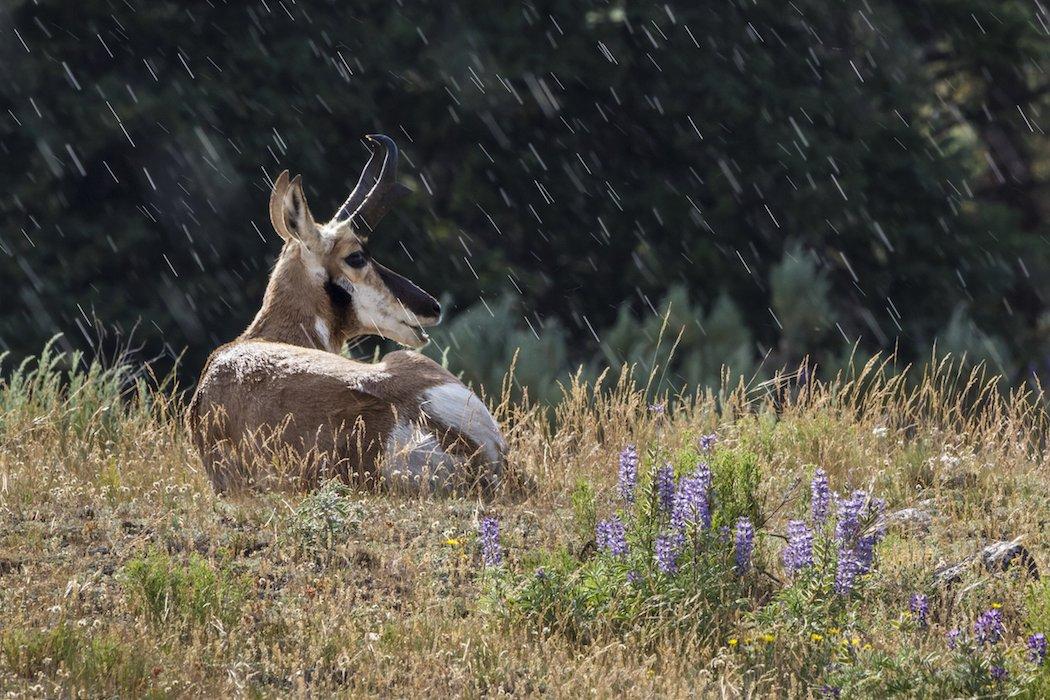Have You Ever Hunted Them During Wet Times?
Water-hole hunting is where it's at for high-odds archery pronghorn hunts. This involves plenty of work before the hunt, but is typically the surest way of collecting antelope with a bow. It also lends itself well to the sweltering weather of early season hunts.
There's only one potential problem with this program -- rain. In the Southwest, archery-only pronghorn seasons invariably coincide with annual monsoons, turning every ditch and low spot into potential watering sites, making water-hole hunting futile. The last time I bowhunted Montana, unexpected rains put a damper on water-hole traffic.
But all is not lost. The resourceful bowhunter simply changes gears and tries other avenues to success.
Spot-and-stalk is the obvious answer. Due to pronghorns' flat, sparsely-vegetated habitat, their 8-power vision especially, many deem prairie goats unstalkable. I've three fine antelope on my wall -- one taken with a recurve -- to prove otherwise. Other than scads of persistance and a willingness to assume undignified positions, the key to stalking within bow range of antelope is picking your terrain. There are places where stalking is impossible; pan-flat terrain with little cover. As a stalking bowhunter, you should seek instead areas with abundant erosion cuts, rim-rock lips, knee-deep sage or scattered trees. Pronghorn certainly aren't averse to traipsing through rough or vegetated terrain, the key is finding them in these vulnerable positions.
Just don't forget to pack knee pads to protect from sharp rocks and hard ground while crawling, leather gloves to deter cactus spines and 3-D camouflage (preferably in Max-1 XT) to confuse the antelope's sharp eyes. It isn't easy, but it sure is exciting when that one-in-10 stalk finally comes together and you find yourself within range of a trophy speed goat. Honing long-range shooting skills is a huge help here.
Decoying is another worthwhile ploy, sometimes productive during August seasons, but best during the late September rut (where available). Decoying early seasons is hit-and-miss at best, with bucks coming through curiosity only, while rutting bucks can prove somewhat fearless in defending territories. The idea is to slip undetected within 200 or 300 yards and downwind of a lone buck or one with a harem of does, and tip the decoy (normally a small buck) into view. Using a snort call to grab his attention is sometimes needed. Rut responses are normally immediate and determined, resulting in close-range shots while using the decoy as cover.
Other blind-dependent strategies include scrape hunting and guarding fence breaks. Antelope scrapes -- pawed-out areas with urine stains and clumped droppings -- are largely ignored by bowhunters, but when rains arrive they are visited often and repeatedly. The best are those at the corners of overlapping territories used by several animals, discovered through smart scouting or close observation. Sitting near fence breaks works best in sheep country where fences are made of tight, woven wire, and when stiff hunting pressure keeps goats moving (antelope generally won't jump fences). This makes it especially productive when sharing the field with rifle hunters or on hard-hunted public lands. Both modes allow use of standard pop-up or pit blinds (where legal).
Don't Miss: 12 Facts About Pronghorns
Are you a deer hunter wanting to learn how to accomplish your goals? Check out our stories, videos and hard-hitting how-to's on deer hunting.








